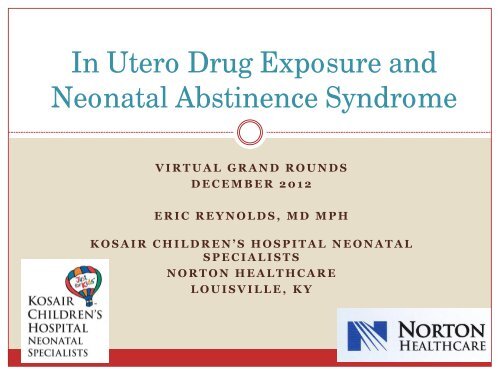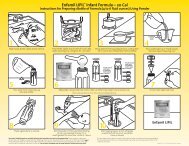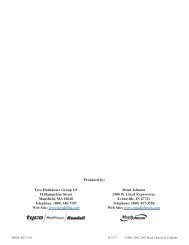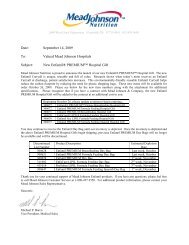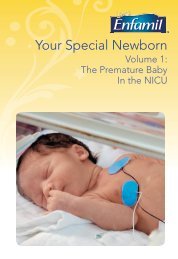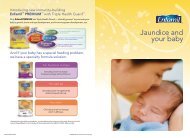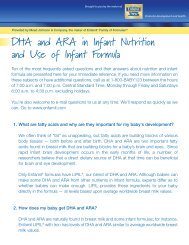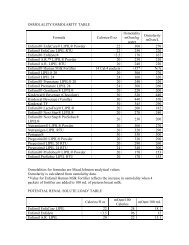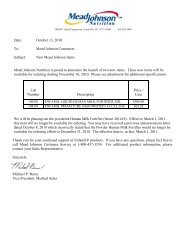Neonatal Abstinence Syndrome PDF Version of Slides
Neonatal Abstinence Syndrome PDF Version of Slides
Neonatal Abstinence Syndrome PDF Version of Slides
Create successful ePaper yourself
Turn your PDF publications into a flip-book with our unique Google optimized e-Paper software.
In Utero Drug Exposure and<br />
<strong>Neonatal</strong> <strong>Abstinence</strong> <strong>Syndrome</strong><br />
V I R T U A L G R A N D R O U N D S<br />
D E C E M B E R 2 0 1 2<br />
E R I C R E Y N O L D S , M D M P H<br />
K O S A I R C H I L D R E N ’ S H O S P I T A L N E O N A T A L<br />
S P E C I A L I S T S<br />
N O R T O N H E A L T H C A R E<br />
L O U I S V I L L E , K Y
Disclosure<br />
• No conflict <strong>of</strong> interest to disclose<br />
• The only FDA approved treatments for withdrawal<br />
in adults are:<br />
◦ Methadone for heroin and other opiates<br />
◦ Benzodiazepines for alcohol<br />
These have been generalized by some physicians to pediatric<br />
populations, but safety and efficacy in patients less than 18<br />
years <strong>of</strong> age have not been established.<br />
• All other treatments to be discussed (including all<br />
NAS treatments), although widely used, are<br />
technically ―<strong>of</strong>f-label‖ uses for these medications.
Objectives<br />
• Discuss the scope <strong>of</strong> the problem <strong>of</strong> in utero drug<br />
exposure and neonatal abstinence syndrome<br />
• Discuss the presentation, signs and symptoms <strong>of</strong><br />
infants affected by neonatal abstinence syndrome<br />
• Discuss some common treatments for NAS
Overview<br />
• Epidemiology<br />
• Common Drugs <strong>of</strong> Abuse<br />
• Detection/Testing<br />
• Signs/Symptoms<br />
• Scoring Systems<br />
• Treatments<br />
• Outcomes
Epidemiology
Epidemiology <strong>of</strong> Drug Use in Pregnancy<br />
• 1991 Seminars in Perinatology<br />
◦ Incidence <strong>of</strong> drug-exposed newborns ranges from 3% to 50%<br />
depending on the specific patient population.<br />
Urban centers tend to report higher rates<br />
• Narcotic use reported in 7.5% <strong>of</strong> pregnancies<br />
◦ Wilbourne et al. J Perinat <strong>Neonatal</strong> Nursing 2001;14:26-45<br />
Mayo Rochester
Epidemiology <strong>of</strong> Drug Use in Pregnancy<br />
• Narcotic use in<br />
pregnancy is<br />
increasing in<br />
Canada.<br />
Kellogg et al. Am J Obstet Gynecol. 2011 Mar;204(3):259.e1-4.
Epidemiology <strong>of</strong> Drug Use in Pregnancy<br />
• Substance Abuse and Mental Health Services<br />
Administration (SAMHSA)<br />
◦ Results <strong>of</strong> 2009 Survey on Drug Use and Health: National<br />
Findings<br />
4.5% <strong>of</strong> pregnant women age 15-44 years used illicit drugs in<br />
the past month.<br />
11.9% report alcohol use.
Epidemiology <strong>of</strong> Drug Use in Pregnancy<br />
• NSDUH (National Survey on Drug Use and<br />
Health) 2008/2009 estimates<br />
2 Year Averaged Rates<br />
Drugs Not Pregnant 15-44y Pregnant 15-44y<br />
Illicit drugs 10.6% 4.5%<br />
Tobacco 27.4% 15.3%<br />
Alcohol 54.4% 10.0%<br />
Substance Abuse and Mental Health Services Administration. (2010). Results from the 2009 National Survey on Drug Use and Health:<br />
Volume I. Summary <strong>of</strong> National Findings (Office <strong>of</strong> Applied Studies, NSDUH Series H-38A, HHS Publication No. SMA 10-4586Findings).<br />
Rockville, MD.
From DEA, printed in Lexington Herald-Leader January 19,2003<br />
Reynolds EW, Dai H, Bada HS. Maternal Poly-Drug Use in a Rural Setting. Peds Res. E-PAS2007:615911.34.
Nonmedical Use <strong>of</strong> Pain Relievers in the Past<br />
Year, Ages 12 and up, 2004-2006 NSDUHs
Epidemic
Maternal Poly-Drug Use in A Rural Population<br />
• Screened 2200 Well-Baby and NICU admission<br />
◦ Risk Criteria<br />
Positive maternal drug history<br />
Positive maternal drug screen<br />
Current or previous CPS involvement<br />
Other siblings not living with mother<br />
Limited or no prenatal care<br />
Positive history <strong>of</strong> STD<br />
Unusual behavior noted by staff<br />
Placenta abruption<br />
Previous fetal demise<br />
Previous preterm birth<br />
Reynolds EW, Dai H, Bada HS. Maternal Poly-Drug Use in a Rural Setting. Peds Res. E-PAS2007:615911.34.
Maternal Poly-Drug Use in A Rural Population<br />
• 245 at-risk babies (9.0%)<br />
◦ 94 (38.4%) were opiate-exposed<br />
Hydrocodone, Oxycodone, Methadone<br />
◦ 50% <strong>of</strong> opiate-exposed babies were also exposed to:<br />
(A) methamphetamine<br />
(B) benzodiazepines<br />
(C) cocaine<br />
◦ 60 (24.4%) <strong>of</strong> 245 were exposed to A, B or C with no opiates<br />
Reynolds EW, Dai H, Bada HS. Maternal Poly-Drug Use in a Rural Setting. Peds Res. E-PAS2007:615911.34.
Maternal Poly-Drug Use in A Rural Population<br />
Characteristic Opiate Other Characteristic Opiate Other<br />
Maternal Age [years] 26.7 + 0.54 25.6 + 0.7 5 minute Apgar [mean (range)] 9 (2,9) 9 (0,10)<br />
Race, white [%] 90 60 GA > 35 weeks [%] 79 88<br />
Not Married [%] 68 78 Male [%] 60 43<br />
Maternal Poly-Drug Use in A Rural Population<br />
• Rural drug-using women are<br />
◦ Mostly white, high-school educated, on Medicaid<br />
◦ NAS is less likely to be a problem in Urban centers since the<br />
drugs more commonly used in those settings are not<br />
associated with withdrawal<br />
◦ They will still have the same issues with home environments,<br />
foster care, etc.<br />
• Proper screening can allow earlier detection and may<br />
improve outcomes.
Eastern Kentucky<br />
• ―Oxycotin Express‖ or ―Kentucky Pain Pill Pipeline‖<br />
◦ ―Doctors Can Help Stem the Kentucky-Florida Drug Pipeline‖<br />
Author is the Medical Director for diagnostic center.<br />
Noticed requests from pain clinics in central Florida for<br />
authentication <strong>of</strong> MRI results.<br />
61% <strong>of</strong> requests made from 2004 to 2009 were forged<br />
documents.<br />
Many <strong>of</strong> the pain clinics operate on a cash basis and have their<br />
own pharmacy.<br />
The diagnostic center instituted a policy that the pain clinics would<br />
have to obtain a KASPER report on the patient to verify no drug<br />
abuse. Some refused.<br />
Kentucky All Schedule Prescription Electronic Reporting<br />
Privett GW. MD Update, Kentucky Edition. March 2011:22-23
Eastern Kentucky<br />
• True story from February 2011<br />
• Vehicle stopped in central Kentucky.<br />
◦ Driver charged with:<br />
Reckless Driving<br />
Driving Under the Influence—second <strong>of</strong>fense<br />
Driving on a suspended license<br />
Possession <strong>of</strong> narcotics with intent to distribute<br />
Possession <strong>of</strong> drug paraphernalia<br />
Possession <strong>of</strong> a concealed deadly weapon without a permit<br />
Dead body in the back seat<br />
• Trio had been to central Florida. Deceased woman<br />
suffered an overdose <strong>of</strong> narcotics. Driver thought<br />
she was ―sleeping it <strong>of</strong>f‖.
Eastern Kentucky<br />
http://richmondregister.com/localnews/x106227990/Woman-indicted-for-not-reporting-passenger-s-death accessed March 30, 2011
Why Drug Abuse?
General Mechanism <strong>of</strong> Reward<br />
• Activation <strong>of</strong> specific neural pathways that originate<br />
in the pons and midbrain and project to the<br />
forebrain.<br />
Ventral<br />
Tegmental<br />
Area<br />
Amygdala,<br />
Medial Prefrontal Cortex<br />
Anterior Cingulate Cortex<br />
Ventral Pallidum<br />
Nucleus Accumbens
General Mechanism <strong>of</strong> Reward
General Mechanism <strong>of</strong> Reward<br />
• The action <strong>of</strong> most drugs <strong>of</strong> abuse is to modulate<br />
dopamine levels in the nucleus accumbens.<br />
◦ Causes feelings <strong>of</strong> euphoria<br />
• Chronic opiate use induces<br />
neuroadaptations.
Which Drugs are Abused?
Specific Drugs <strong>of</strong> Abuse<br />
• Opioids<br />
◦ Agonists<br />
◦ Antagonists<br />
◦ Mixed agonistantagonists<br />
◦ Semi-synthetic<br />
opioids<br />
• CNS stimulants<br />
◦ Amphetamines<br />
◦ Methamphetamines<br />
◦ Cocaine<br />
◦ Methylphenidate<br />
(Ritalin)<br />
◦ Pemoline (Cylert)<br />
◦ Phenylpropanolamine<br />
◦ Phencyclidines
Mechanism <strong>of</strong> Cocaine
Specific Drugs <strong>of</strong> Abuse<br />
• CNS depressants<br />
◦ Alcohol<br />
◦ Barbiturates<br />
◦ Benzodiazepines<br />
◦ Cannabinoids<br />
(marijuana, hashish)<br />
• Other sedativehypnotics<br />
◦ Methaqualone<br />
(Quaalude)<br />
◦ Ethchlorvynol<br />
(Placidyl)<br />
◦ Glutethimide<br />
(Doriden)<br />
◦ Methyprylon (Noludar)<br />
◦ Ethinamate (Valmid)<br />
◦ Chloral hydrate
Effect <strong>of</strong> THC and Benzodiazepines
Specific Drugs <strong>of</strong> Abuse<br />
• Hallucinogens<br />
◦ LSD<br />
◦ Phenylethylamine<br />
(mescaline)<br />
◦ Phenylisopropylamines<br />
(MDA, MMDA, MDEA,<br />
MDMA [3,4-methylenedioxymethampheta<br />
mine or ecstasy])<br />
• Inhalants<br />
◦ Solvents and aerosols<br />
(glues, gasoline, paint<br />
thinner, etc.)<br />
• Nitrites<br />
• Nitrous oxide
SSRIs<br />
• Late gestation in utero<br />
exposure to SSRIs is<br />
associated with a neonatal<br />
behavioral syndrome<br />
characterized particularly<br />
by CNS symptoms.<br />
◦ Symptoms seem to resolve<br />
over the course <strong>of</strong> days with<br />
supportive treatment in most<br />
cases.<br />
◦ If pharmacotherapy is<br />
needed, the best approach is<br />
unclear.<br />
Moses-Kolko. JAMA May 2005;293(19):2372-2383
SSRIs<br />
• WHO Database Review<br />
◦ 2001-2003: 93 reports <strong>of</strong><br />
SSRI-associated neonatal<br />
abstinence syndrome.<br />
64 with paroxetine<br />
No discussion <strong>of</strong><br />
treatment<br />
◦ Regardless <strong>of</strong> if you call it<br />
―withdrawal‖ or not,<br />
SSRIs do have an effect<br />
on the fetus/newborn.<br />
Sanz et al. Lancet 2005;365:482-487
Medication Assisted Treatment<br />
<strong>of</strong> Addiction in Pregnancy
Addiction Treatment During Pregnancy<br />
• <strong>Abstinence</strong> is not likely to be effective and may be a<br />
barrier to seeking treatment.<br />
• Medical treatment usually consists <strong>of</strong> replacement<br />
and maintenance on a controlled and supervised<br />
regimen.<br />
• May have to increase dose in last few weeks <strong>of</strong><br />
pregnancy due to increased maternal metabolism<br />
and volume <strong>of</strong> distribution.
Addiction Treatment During Pregnancy<br />
• Methadone<br />
◦ Used for decades<br />
◦ Most commonly prescribed opioid in pregnancy since 1965.<br />
◦ Causes NAS in 60-80% <strong>of</strong> pregnancies<br />
◦ Length <strong>of</strong> treatment about 3 weeks<br />
• Morphine<br />
◦ Oral, slow-release<br />
◦ Length <strong>of</strong> treatment about 2 weeks<br />
• Buprenorphine<br />
◦ Multiple small studies suggest less NAS and shorter length <strong>of</strong><br />
treatment (1.1 days)<br />
◦ Actual experience may vary. New data expected soon.<br />
Levy LW, Spino DJ. Pharmacotherapy. 1993;13:202-210.<br />
Fischer G, Jagsch R, Eder H, et al. Addiction. 1999;94:231-239.<br />
Fischer G, Johnson JE, Eder H, et al. Addiction. 2000;95:239-244.
Description<br />
• Babies were exposed to the following drugs:<br />
n<br />
Buprenorphine<br />
Methadone<br />
Prescription Pain<br />
Antidepressants<br />
Heroin<br />
Benzodiazepines<br />
Barbiturates<br />
Cocaine<br />
Amphetamine<br />
Alcohol<br />
THC<br />
Phenergan<br />
Other<br />
CONT 155 0 55 109 18 2 44 13 15 7 1 22 8 15<br />
BUP 24 24 5 15 1 2 0 8 0 4 2 5 0 0<br />
Presented at PAS/SPR 2012
Results<br />
CONT BUP p<br />
n 155 24<br />
GA at Birth (mean, wks) 38 39 n.s.<br />
Length <strong>of</strong> hospitalization (median, days) 10 17 0.002<br />
Length <strong>of</strong> Inpatient Treatment (median, days) 4 15.5 0.001<br />
Outpatient Length <strong>of</strong> Treatment (median, days) 0 8.5 0.002<br />
Total Length <strong>of</strong> Treatment (median, days) 4 34
Results<br />
n 6<br />
Length <strong>of</strong> hospitalization (median, days) 23<br />
Length <strong>of</strong> inpatient treatment (median,<br />
days)<br />
Length <strong>of</strong> outpatient treatment (median,<br />
days)<br />
BUP exposure<br />
only<br />
19<br />
26<br />
Length <strong>of</strong> total treatment (median, days) 45<br />
No pharmacologic treatment required 33%
Detection
Detecting Drug Exposure<br />
• Maternal Screening<br />
◦ History, Self Report<br />
Unreliable, depends on patient and interviewer<br />
Canadian Study<br />
<strong>Neonatal</strong> urine testing indicates 27% <strong>of</strong> mothers did not<br />
admit to substances detected in the infant.<br />
24% <strong>of</strong> meconium screens detected additional substances<br />
other than what the mothers admitted to.<br />
Murphy-Oikonen et al. J Perinat Neonat Nurs. 2010;24(4)366-372
Detecting Drug Exposure<br />
◦ Suspicion (Risk Factors)<br />
Gravida 4 or more<br />
No or late prenatal care<br />
Previous children not living with mother<br />
History <strong>of</strong> CPS involvement<br />
Abruption<br />
Physical injuries<br />
History <strong>of</strong> chronic pain<br />
STDs, Other risky behavior<br />
Disorientation, confusion during interviews<br />
◦ Maternal urine or hair testing
Maternal Dosage and NAS<br />
• It is commonly accepted that the maternal dose <strong>of</strong> the<br />
replacement therapy does not affect the risk <strong>of</strong> NAS.<br />
◦ Studies are confounded by poly-drug exposure<br />
Mixed results<br />
◦ It is thought by some that larger doses late in pregnancy do<br />
correlate with the risk <strong>of</strong> symptoms.<br />
◦ Weaning dose late in pregnancy vs. maintaining or escalating<br />
◦ Symptoms do correlate with cord-blood methadone levels<br />
Differences in pharmacogenetics/kinetics can lead to variation in<br />
cord-blood levels.<br />
Kuschel CA et al. Arch Dis Chld Fetal <strong>Neonatal</strong> Ed. 2004;89:390-393
Delivery Room Contraindication<br />
• No Narcan (naloxone) to an infant <strong>of</strong> a known<br />
opiate-using (heroine) mother.<br />
◦ Abrupt withdrawal can illicit seizures<br />
◦ Has been removed from NRP as a resuscitation medication.
Detecting Drug Exposure<br />
• Infant Screening<br />
◦ Urine Drug Screen<br />
Detects recent exposure<br />
◦ Meconium Drug Screen<br />
Detects prolonged or not recent exposure<br />
Beyond 20 weeks gestation<br />
Expanded opiate testing required to detect oxycodone,<br />
propoxyphene and methadone<br />
May not be available<br />
Early passage (fetal stress), limited or delayed passage (very<br />
preterm)<br />
◦ Universal Screening?<br />
Regulations, privacy?
Detecting Drug Exposure<br />
• Other tests<br />
◦ Umbilical cord tissue<br />
Easy, noninvasive, quick, long window <strong>of</strong> exposure detection<br />
Specialized testing<br />
◦ <strong>Neonatal</strong> hair<br />
Present on the fetus after 6 months <strong>of</strong> gestation<br />
Can be used during the first 3 months <strong>of</strong> life
Signs/Symptoms
General Mechanism <strong>of</strong> Withdrawal<br />
• Increased firing rate <strong>of</strong> the locus coeruleus and<br />
elevated activity <strong>of</strong> in the autonomic nervous system.
Signs/Symptoms<br />
• CNS dysfunction<br />
◦ High-pitched cry<br />
◦ Restlessness<br />
◦ Hyperactive reflexes<br />
◦ Jitteriness<br />
◦ Tremors<br />
◦ Hypertonia<br />
◦ Myoclonic Jerks<br />
◦ Seizure<br />
• Metabolic and<br />
Vasomotor Disturbance<br />
◦ Sweating<br />
◦ Fever<br />
◦ Mottling<br />
◦ Yawning
Signs/Symptoms<br />
• GI Dysfunction<br />
◦ Excessive Sucking<br />
◦ Poor Feeding<br />
◦ Hyperphagia<br />
◦ Vomiting<br />
◦ Loose Stools<br />
◦ Severe diaper rash<br />
• Respiratory Symptoms<br />
◦ Sneezing<br />
◦ Nasal Flaring<br />
◦ Tachypnea<br />
◦ Apnea<br />
• Other<br />
◦ Abrasions<br />
◦ Excoriations
Drug Effects vs. NAS<br />
• Early exposure affects brain growth and<br />
development<br />
◦ Decreased head circumference and other growth parameters<br />
◦ µ-receptor agonist exposure results in decreased cortical<br />
neuronal density, smaller dendritic arborization and branching<br />
in animal studies.<br />
µ agonists decrease cell division<br />
◦ Can result in hypertonicity, hypereflexia, irritability, tremors,<br />
shrill cry and behavioral disturbances.<br />
• Gross structural abnormalities have been reported<br />
◦ Hydrocephalus and heroin<br />
◦ Stroke and codeine
<strong>Neonatal</strong> <strong>Abstinence</strong> <strong>Syndrome</strong> and<br />
Cerebral Infarction Following Maternal<br />
Codeine Use During Pregnancy<br />
REYNOLDS EW, RIEL -ROMERO RMS,<br />
BADA HS<br />
C L I N P E D I A T R 2 0 0 7 ; 4 6 ( 7 ) : 6 3 9 - 6 4 5
Codeine-Containing Cough Medication<br />
• Codeine is an opiate and can cause NAS.<br />
• Many women do not consider prescription cough<br />
syrups when asked about drug use.<br />
• Opiate use in pregnancy has been linked to perinatal<br />
cerebral infarction.
Case 1<br />
• 39-week infant, unremarkable delivery<br />
• Mother denies any history <strong>of</strong> drug use.<br />
• 2 weeks prior to delivery, the mother had a<br />
severe URI for which she was prescribed a<br />
combination cough preparation.<br />
◦ 6.25mg promethazine HCl / 5 ml<br />
◦ 10 mg codeine phosphate / 5 ml<br />
Total dose 500-600 mg <strong>of</strong> codeine
Case 1<br />
• At a few hours <strong>of</strong> life the baby had abnormal<br />
posturing with arching and seizures.<br />
• Baby drug screen positive for codeine and morphine.<br />
◦ (Codeine is metabolized to morphine.)<br />
• Evaluation<br />
◦ EEG<br />
Subclinical seizures arising from the left hemisphere<br />
◦ All other work-ups including sepsis, coagulapathy,<br />
cardiology and metabolic disease pr<strong>of</strong>iling were negative.
Case 1<br />
• Imaging<br />
◦ MRI on DOL 3<br />
Left middle and anterior cerebral artery infarction<br />
Edema <strong>of</strong> the left cerebral peduncle and pons<br />
Residual clot in the internal carotid artery
MRI
Case 1<br />
◦ NAS symptoms were controlled with phenobarbital,<br />
and the baby was discharged to home.<br />
◦ 2 month follow-up<br />
No seizures but persistent focal neurologic findings
Case 2<br />
• 38-week infant, unremarkable delivery<br />
• No maternal drug history<br />
• 2 weeks prior to delivery the mother was<br />
hospitalized with pneumonia<br />
◦ Treated with a codeine containing-cough medicine<br />
• 33 hours <strong>of</strong> life, baby developed clinical seizures<br />
◦ Seizures controlled with combination <strong>of</strong> phenobarbital and<br />
lorazepam
Case 2<br />
• EEG<br />
◦ Ictal discharges from the left hemisphere with associated<br />
clinical desaturation episode<br />
◦ Bihemispheric slow wave activity (diffuse cerebral<br />
dysfunction)<br />
• All other work-ups including sepsis, coagulapathy,<br />
cardiology and metabolic disease pr<strong>of</strong>iling were<br />
negative.
Case 2<br />
• MRI<br />
◦ Infarction in the left occipito-temporal region<br />
◦ Old blood and hemosiderin deposition<br />
◦ Occipital encephalomalacia
MRI
Case 2<br />
• NAS symptoms were controlled with medication.<br />
• Follow-up<br />
◦ Infant was discharged to home with phenobarbital and<br />
lorazepam treatment.<br />
◦ Good seizure control at 1 year follow-up
Discussion<br />
• Diffuse cerebral infarction has been described as a<br />
result <strong>of</strong> other drugs that induce vasospasm and<br />
hypercoaguability.<br />
◦ Methanol<br />
◦ Cocaine<br />
◦ Heroine
Discussion<br />
• Codeine, like other opiates, can have adverse effects<br />
on the fetus and neonate.<br />
• This class <strong>of</strong> drugs is known to have effects on<br />
cerebral vasculature.<br />
• Importance <strong>of</strong> history taking can not be over<br />
emphasized.<br />
◦ Ask the right question!<br />
Mother may not consider prescribed cough medicine when asked<br />
about drug use.<br />
• NAS can occur in infants <strong>of</strong> ―non-addicted‖ mothers.
Discussion<br />
• Routine, universal urine or meconium drug screens<br />
may be warranted.<br />
• Physicians should consider maternal opiates or<br />
codeine use when evaluating a newborn with<br />
perinatal stroke.<br />
• These findings could easily be generalized to other<br />
drugs or medications with vaso-occlusive<br />
properties or drugs which induce hypercoaguable<br />
states.
Symptom Assessment
Scoring Systems<br />
• All are based on opiate withdrawal<br />
◦ May not be effective for all types <strong>of</strong> exposure<br />
• Most are based on behaviors <strong>of</strong> term newborns<br />
◦ May not be appropriate for preterm infants<br />
◦ Older infants may require adjustments to the interpretation <strong>of</strong><br />
the scores.<br />
• Decision to initiate treatment based on single or<br />
serial scores<br />
◦ No studies compared different thresholds for starting<br />
treatment as to short-term outcomes.
Scoring Systems<br />
• Finnegan<br />
◦ Assessment <strong>of</strong> 21 common symptoms <strong>of</strong> NAS with weighted<br />
scores for each symptom<br />
Pharmacotherapy after score <strong>of</strong> 8<br />
Most commonly used form<br />
◦ Considered too complex by some<br />
Finnegan et al. Addict Dis. 1975;2(1-2):141-58.
Finnegan Scoring<br />
System: CNS Disturbances<br />
Score<br />
Cry (excessive, continuous) 2 - 3<br />
Sleep (
Finnegan Scoring<br />
Gastrointestinal Disturbances<br />
Score<br />
Excessive Sucking 1<br />
Poor Feeding 2<br />
Regurgitation / projectile vomiting 2 - 3<br />
Loose stools / watery stools 2 - 3<br />
Respiratory System manifestations Score<br />
Nasal Flaring 2<br />
Respiratory rate >60/min / RR >60/min and<br />
retractions<br />
1 - 2
Finnegan Scoring<br />
Other Disturbances (Autonomic)<br />
Score<br />
Sweating 1<br />
Fever 37.3 – 38.3 C / =>38.4 C 1 - 2<br />
Frequent yawning (>3-4 in 4 hr) 1<br />
Mottling 1<br />
Nasal stuffiness 2<br />
Sneezing (>3-4 in 4 hr) 1
Scoring Systems<br />
• Lipsitz<br />
◦ 11 items…less focus on autonomic dysfunction<br />
Does not include sleep, myoclonic jerks, seizure, suckle feeding,<br />
retractions, flaring (includes rate and sneezing) or sweating.<br />
Only provides subjective ratings <strong>of</strong> some symptoms (yes/no)<br />
Pharmacotherapy after score <strong>of</strong> 4<br />
• Ostrea<br />
◦ 6 item simple scale (yes/no)<br />
no guidelines for pharmacotherapy<br />
◦ Does not allow for summing <strong>of</strong> multiple symptoms,<br />
Widely viewed as insufficient
Scoring Systems<br />
• <strong>Neonatal</strong> Withdrawal Inventory<br />
◦ Checklist <strong>of</strong> 7 NAS symptoms, 4 point behavioral distress scale<br />
Pharmacotherapy after score <strong>of</strong> 8<br />
• <strong>Neonatal</strong> Narcotic Withdrawal Index<br />
◦ 6 signs <strong>of</strong> NAS plus ―other‖ category <strong>of</strong> 12 signs<br />
Pharmacotherapy after score <strong>of</strong> 5<br />
• <strong>Neonatal</strong> Brazelton Neurobehavioral Scales (NBAS)<br />
◦ 5 symptoms, No guidelines for pharmacotherapy, Requires<br />
certified examiner<br />
• <strong>Neonatal</strong> Network Neurobehavioral Scales (NNNS)<br />
◦ Similar to NBAS, Includes stress/abstinence signs<br />
◦ May be helpful in preterm infants
Treatments
Treatment: Nonpharmacologic<br />
• Supportive Treatment<br />
◦ Swaddling, Positioning<br />
◦ Small frequent feedings with high calorie formula<br />
Lactose-free formula?<br />
◦ IV fluids<br />
◦ Decrease sensory stimulation<br />
◦ Monitor closely for other diseases<br />
◦ Monitor weight gain (too much or too little)<br />
◦ Bundle assessments, interventions and examinations<br />
◦ Environmental control
Swaddling<br />
From Helping Hands: Caregivers’ Guide for Drug-Exposed Infants. Richards B, Drennen B. 2000
C-Position<br />
From Helping Hands: Caregivers’ Guide for Drug-Exposed Infants. Richards B, Drennen B. 2000
C-Position<br />
From Helping Hands: Caregivers’ Guide for Drug-Exposed Infants. Richards B, Drennen B. 2000
Side-Lying with Boundaries<br />
From Helping Hands: Caregivers’ Guide for Drug-Exposed Infants. Richards B, Drennen B. 2000
Vertical Rock<br />
From Helping Hands: Caregivers’ Guide for Drug-Exposed Infants. Richards B, Drennen B. 2000
Clap and Sway<br />
From Helping Hands: Caregivers’ Guide for Drug-Exposed Infants. Richards B, Drennen B. 2000
• Goals<br />
Treatment: Pharmacologic<br />
◦ Treat with drug from same class as exposure<br />
◦ Minimize symptoms<br />
◦ Promote appropriate growth and weight gain<br />
◦ Promote care-taker:child interaction<br />
• Concerns about multiple exposures and ―therapeutic‖<br />
sedation effects.<br />
• Optimal regimen has not been established.<br />
◦ Considerable heterogeneity in the diagnosis and treatment.<br />
• Only clearly defined benefit <strong>of</strong> pharmacologic treatment<br />
is the short-term amelioration <strong>of</strong> clinical signs.<br />
◦ Unknown if long-term morbidity is changed by pharmacotherapy.
Treatments: Pharmacologic<br />
• Morphine<br />
◦ Often requires frequent dosing, most common treatment.<br />
◦ Wide range in reported length <strong>of</strong> treatment (8-79 days)*<br />
• Methadone<br />
◦ Long half-life allows q day dosing but makes titration difficult<br />
• Phenobarbital<br />
◦ Q day dosing, monitoring levels encouraged<br />
◦ Commonly used as a second-line or adjunctive therapy<br />
*Kraft et al. Addiction. 2010;106:574-580
Treatments: Pharmacologic<br />
• Tincture <strong>of</strong> Opium<br />
◦ Measured in drops/kg. Frequent dosing.<br />
◦ TOO + Phenobarbital is more effective than Phenobarbital alone<br />
• Paregoric<br />
Coyle M. et al. J Pediatr 2002;140:561-564.<br />
◦ Declining use due to side effects<br />
Contains isoquinolone, camphor, ethanol, anise oil, benzoic acid,<br />
benzyl alcohol, glycerine<br />
Very good for control <strong>of</strong> GI symptoms<br />
• Chlorpromazine<br />
◦ Controls GI and CNS symptoms<br />
◦ Slow elimination (1/2 life = 3 days)<br />
◦ Contains benzyl alcohol<br />
◦ Side effects include cerebellar dysfunction and decreased seizure<br />
threshold
Treatments: Pharmacologic<br />
• Diazepam<br />
◦ Concerns for poor feeding, increased sedation, seizures<br />
◦ Contains benzyl alcohol and sodium benzoate<br />
Contraindicated in jaundiced and preterm infants<br />
Bilirubin displacement<br />
• Buprenorphine<br />
◦ Few studies. Mostly small safety studies<br />
◦ Suggestion <strong>of</strong> shorter treatment
• Clonidine<br />
Treatment: Pharmacologic<br />
◦ Nonnarcotic, decreases sympathetic outflow<br />
◦ Effective for treatment <strong>of</strong> abstinence syndrome in adults<br />
◦ 1984:(n=7): Effective for 6 infants, Shorter length <strong>of</strong> treatment<br />
◦ 2009 : (n=14, 3 from maternal opiate)<br />
Lower NAS scores after starting treatment with clonidine<br />
◦ 2009 RCT (n=80, Tx DTO ½ with Clonidine vs. Placebo)<br />
Shorter length <strong>of</strong> Tx, None required restarting tx after completion (7 in<br />
placebo group), lower DTO dose, no tx failure (12.5% in placebo)<br />
◦ 2010 NAS study (n=133) Germany<br />
29 Clonidine +/- Chloral Hydrate, 64 Morphine +/- Phenobarbital<br />
Shorter LOS in clonidine group (14 vs. 35 days)<br />
◦ 2010 Cochrane Review <strong>of</strong> Sedatives for NAS<br />
Less enthusiastic, but suggested it may reduce the severity <strong>of</strong> withdrawal<br />
Houston MC. Southern Med Journal. 1982;75(6):713-721 Hoder et al. Psychiatry Research 1984;13:243-251<br />
Leikin JB, et al. Clinical Toxicology. 2009;47:551-555 Esmaeili A et al. Acta Pediatrica. 2010;99:209-214<br />
Osborn DA, et al. Cochrane Database Syst Rev. 2010 Oct 6;(10):CD002053 Agthe AG, et al. Pediatrics 2009 May;123(5):e849-56.Epub 2009 Apr 27.
National Survey: Management <strong>of</strong> NAS<br />
• 75 / 102 responded<br />
• 41 (55%) have a written policy on management<br />
• 49 (65%) use Finnegan Scores<br />
◦ 3 use Lipsitz<br />
• Treatments<br />
◦ Opioid exposure: 63% use tincture <strong>of</strong> opium or morphine<br />
◦ Polydrug exposure: 52% use tincture <strong>of</strong> opium or morphine<br />
Sarkar and Donn, J Perinatology 2006;26:15-17
National Survey: Management <strong>of</strong> NAS<br />
Opioid Exposure<br />
First Line<br />
Added Second Line<br />
Opioids - 47(63%) Phenobarbital (24), IV morphine (10),<br />
Methadone (8), Clonidine (3),<br />
Diazepam (2)<br />
Methadone - 15(20%) Oral morphine (6) Phenobarbital (4),<br />
Tincture Opium (3), Clonidine (2)<br />
Phenobarbital – 13(17%) Oral morphine (4), Methadone (4),<br />
Tincture <strong>of</strong> opium (3), Diazepam (2)<br />
Sarkar and Donn, J Perinatology 2006;26:15-17
National Survey: Management <strong>of</strong> NAS<br />
Polydrug Exposure<br />
First Line<br />
Added Second Line<br />
Opioids – 39 (52%) Phenobarbital (27), Methadone (3),<br />
Clonidine (2), Diazepam (1),<br />
Variable (6)<br />
Phenobarbital – 24(32%) Opioids (8) Diazepam (8),<br />
Methadone (4), Rarely seen (4)<br />
Methadone – 8 (10.6%) Phenobarbital (4), Opioids (3),<br />
Diazepam (1)<br />
Rarely seen – 4 (5.4%)<br />
Sarkar and Donn, J Perinatology 2006;26:15-17
Treatment Regimens<br />
• These are some treatment regimens commonly used. None have been<br />
proven effective, or more-or-less effective than any others.<br />
• Common Treatment<br />
◦ Morphine 0.1 mg per dose q 4 hours, titrate to effect for scores<br />
over 8 (or 10).<br />
• UCSF website<br />
◦ DTO 0.1 mL/kg q 3-4, increase by 0.05-0.1 mL increments<br />
until symptoms controlled.<br />
Can use phenobarbital or diazepam as adjunctive treatments
Treatment Regimens<br />
• Newborn Emergency Transport Services (NETS)<br />
(Australia)<br />
Score<br />
Dosage (oral)<br />
3 consecutive scores<br />
average 8 or more<br />
2 consecutive scores<br />
average 12 or more<br />
0.5 mg/kg/day<br />
divided q 6 hours<br />
0.5-0.7 mg/kg/day<br />
divided q 6 hours<br />
◦ Treat with morphine as noted.<br />
◦ Use birth weight for calculations<br />
◦ Change to q 4 dosing if symptoms are not controlled on q 6.
Treatment Regimens<br />
• Another US academic center<br />
For 3 consecutive scores >8…. or 2 consecutive scores >12….<br />
or 1 score >15: Begin morphine 0.05 mg/kg/dose q 4 p.o.<br />
For 2 scores >15 use IV morphine at 0.1 mg/kg/dose q 4<br />
Change to oral dosing when scores are less 8 in a 24 hour<br />
period. Wean dose every 48%.<br />
When dose is 0.025 mg/kg/dose, increase interval sequentially to 6,<br />
8 and 12 hours. If phenobarbital was started, d/c 24 hours post<br />
morphine.
Treatment Regimens<br />
• Finnegan Scoring Q 3 hour.<br />
◦ If baby receives a score other than Cat 0, rescore in 1 hour.<br />
◦ If baby returns to Cat 0, return to q 3 hour scoring.<br />
◦ If baby continues to score in a category other than 0, use the<br />
higher score to determine the treatment dose.<br />
Category Score<br />
Initiation <strong>of</strong> Oral Morphine<br />
Treatment Dose Escalation Dose Re-escalation<br />
Category 0 0-8 Return to q 3 scoring no change not applicable<br />
Category 1 9-12 0.04 mg q 4 hours 0.02 mg per dose 0.01 mg per dose<br />
Category 2 13-16 0.08 mg q 4 hours 0.04 mg per dose 0.02 mg per dose<br />
Category 3 17-20 0.12 mg q 4 hours 0.06 mg per dose 0.03 mg per dose<br />
Category 4 >20 0.16 mg q 4 hours 0.08 mg per dose 0.04 mg per dose<br />
Adapted from Jansson et al. J Opioid Manag. 2009;5(1):47-55
Treatment Regimen<br />
• When Category 0 scores are obtained for 48 hours on a<br />
particular morphine dose, begin weaning.<br />
◦ Wean dose by 0.02 mg q 24 hours as long as scores remain in<br />
Category 0.<br />
• If a score other than Category 0 is obtained during the<br />
weaning process, rescore in 1 hour to determine if an<br />
increased dose is required. Re-escalate the dose<br />
according to the chart.<br />
Category Score<br />
Initiation <strong>of</strong> Oral Morphine<br />
Treatment Dose Escalation Dose Re-escalation<br />
Category 0 0-8 Return to q 3 scoring no change not applicable<br />
Category 1 9-12 0.04 mg q 4 hours 0.02 mg per dose 0.01 mg per dose<br />
Category 2 13-16 0.08 mg q 4 hours 0.04 mg per dose 0.02 mg per dose<br />
Category 3 17-20 0.12 mg q 4 hours 0.06 mg per dose 0.03 mg per dose<br />
Category 4 >20 0.16 mg q 4 hours 0.08 mg per dose 0.04 mg per dose<br />
Adapted from Jansson et al. J Opioid Manag. 2009;5(1):47-55
Treatment Regimen<br />
• Pediatric Interim Care Center (<strong>Neonatal</strong> abstinence hospital in<br />
Kent, WA).<br />
◦ Use Finnegan Score System<br />
◦ Treat if NAS score >10 x 3 or >12 x 2 in a 24 hour period.<br />
◦ Morphine 0.4 mg/mL<br />
0.2 mL po q 3 hours (coincides with feeding)<br />
Increase dose by 10% every 3 hours until symptoms are controlled.<br />
Increase by 10% during later course <strong>of</strong> treatment if NAS scores<br />
increase.<br />
Monitor for side effects…HR
Analysis <strong>of</strong> Treatments<br />
• Cochrane meta-analysis<br />
◦ 7 studies—585 infants—1983-2004<br />
◦ 1 study <strong>of</strong> oral morphine vs. non-phamacologic treatment<br />
Morphine increased duration <strong>of</strong> treatment and length <strong>of</strong><br />
hospitalization, but reduced days to regain birthweight<br />
◦ 4 studies compared opioids to phenobarbital<br />
No difference in treatment failures<br />
◦ 1 study reported less seizure in opioid treated infants than<br />
those with supportive care only.<br />
◦ 3 studies showed less treatment failure with opioids than with<br />
diazepam.<br />
Osborn et al. Cochrane Database Syst Rev. 2005;(3):CD002059
Analysis <strong>of</strong> Treatments<br />
• 2 nd Cochrane review<br />
◦ 6 trials—305 infants—1969-2002<br />
Sedative treatment vs. nonopioid treatment<br />
Phenobarbital increased length <strong>of</strong> treatment and hospitalization<br />
Study <strong>of</strong> second line treatment after failure on DTO<br />
• Phenobarbital shortened hospital stay and decreased opioid dose.<br />
Phenobarbital vs. diazepam—less failure in phenobarb group<br />
Phenobarb vs. Chlorpromazine—no difference<br />
Osborn et al. Cochrane Database Syst Rev. 2005;(3):CD002053
Other Studies<br />
• Oral morphine vs. DTO<br />
◦ No difference for duration <strong>of</strong> treatment, duration <strong>of</strong><br />
hospitalization or weight gain.<br />
• Methadone vs. Morphine<br />
◦ No difference in length <strong>of</strong> hospitalization<br />
• Morphine vs. Phenobarbital<br />
◦ Shorter treatment with phenobarbital<br />
• Buprenorphine vs. DTO<br />
◦ Non-significant reduction in LOS with Bup<br />
Langenfeld et al. Drug Alcohol Depnd. 2005;77(1):31-36<br />
Lainwalla et al. Adv <strong>Neonatal</strong> Care. 2005;5(5):265-272<br />
Ebner et al. Drug Alcohol Depnd. 2007;87(2-3):131-130<br />
Kraft et al. Pediatrics 2008:122(3) e601
To Breastfeed or Not To Breastfeed,<br />
That is the question?<br />
• Controversial<br />
◦ Continued exposure to maternal drugs <strong>of</strong> abuse<br />
Little transmission to breastmilk<br />
Helps control the symptoms <strong>of</strong> NAS<br />
What if mother is in a program with close monitoring?<br />
◦ CAUTION<br />
◦ Contraindicated if continued use <strong>of</strong> THC
Codeine in Breast Milk<br />
• 2006 report <strong>of</strong> a Toronto infant<br />
• Mother given Tylenol 3 for episiotomy pain.<br />
◦ Initially 2 tab (60mg) q 12, but cut to 1 tab (30mg) q<br />
12 after 2 days<br />
Less than the usual amount required<br />
• At 7 days <strong>of</strong> life, parents noticed the infant to<br />
be lethargic.<br />
• At 11 days <strong>of</strong> life, baby was brought to the<br />
pediatrician for poor feeding and jaundice.<br />
• On day 13 he was dead.
Codeine in Breast Milk<br />
• Autopsy found the infant to have a blood morphine<br />
level <strong>of</strong> 70 ng/ml.<br />
◦ 6x higher than normally considered safe for neonates<br />
• The mother’s breast milk had a morphine<br />
concentration <strong>of</strong> 87 ng/mL.<br />
◦ Typical range <strong>of</strong> milk concentrations after 60 mg every 6 h is<br />
1.9–20.5 ng/mL.
Codeine in Breast Milk<br />
• Codeine is metabolized to morphine by<br />
O-demethylation by CYP 2D6 (part <strong>of</strong> P450 system).<br />
• Mother carried three copies <strong>of</strong> CYP 2D6 gene<br />
◦ She is an ―ultra-rapid‖ metabolizer <strong>of</strong> codeine to morphine<br />
• Maternal grandfather, FOB and baby had 2 copies<br />
◦ They are ―rapid‖ metabolizers.<br />
• ―Ultra-rapid‖ metabolizers by ethnicity<br />
◦ Finland/Denmark 1% Ethiopia 29%<br />
◦ Greece/Portugal 10% African and Asian 30%<br />
• Limit codeine use in pregnant and breast-feeding<br />
mothers.
Swallow-Breath Interaction and Drug-Exposure<br />
• During nonnutritive suck in low-risk preterm<br />
infants, swallow and breath interact in 2 ways.<br />
◦ How: Central Apnea, Obstructive Apnea, Attenuated<br />
Respiration. (Sw:Br)<br />
◦ Where: Babies can swallow at any point in the respiratory<br />
cycle: Beg Exp, Mid Exp, End Exp, Mid Insp, Apnea. (POR)
Phase <strong>of</strong> Respiration<br />
Beginning<br />
Expiration<br />
Apnea<br />
mV<br />
inspiration<br />
Mid-Expiration<br />
End<br />
Expiration<br />
Mid-Inspiration<br />
time
Swallow-Breath Interaction and Drug-Exposure<br />
• During nonnutritive suck in low-risk preterm<br />
infants, swallow and breath interact in 2 ways.<br />
◦ How: Central Apnea, Obstructive Apnea, Attenuated<br />
Respiration. (Sw:Br)<br />
◦ Where: Babies can swallow at any point in the respiratory<br />
cycle: Beg Exp, Mid Exp, End Exp, Mid Insp, Apnea. (POR)<br />
◦ The ―How‖ is affected by the amount <strong>of</strong> practice the infant<br />
gets…Learning?<br />
◦ The ―Where‖ is not affected by practice…Maturation?
Swallow-Breath Interaction and Drug-Exposure<br />
• We compared a drug-exposed cohort to a group <strong>of</strong><br />
term control infants.<br />
◦ The NAS infants differ from the term controls in the type <strong>of</strong><br />
Sw:Br interaction, but not in the POR.<br />
The maturational component progresses similarly in the control<br />
and NAS infants.<br />
The learned component does not progress the same at the control<br />
infants.<br />
Do they ever catch up?<br />
Do they have to catch up?<br />
Long term questions?<br />
Implications?
Baby Outcomes
Outcomes<br />
• Few studies<br />
• Confounding variables:<br />
◦ unsafe/unhealthy home environment,<br />
◦ dysfunctional care-givers,<br />
◦ fetal growth restriction,<br />
◦ poly-drug exposure<br />
• Barker Hypothesis: alterations in fetal nutrition and<br />
endocrine status result in developmental adaptations<br />
that permanently change structure, physiology and<br />
metabolism, predisposing individuals to later disease
Outcomes<br />
• Bayley scores do not seem to be affected by choice <strong>of</strong><br />
treatment (phenobarbital, paragoric, both)<br />
◦ Small study (n=69)<br />
Kaltenbach K , Finnegan LP. Neurobehav Toxicol Teratol 1986;8353-355<br />
• Withdrawal associated seizures do not carry<br />
increased risk <strong>of</strong> poor outcome.<br />
• Increased risk <strong>of</strong> addition in adulthood, even if<br />
placed in ―nontoxic‖ environment.
Nursing Outcomes
Nursing Experience<br />
• NICU nurses spend a large amount <strong>of</strong> time soothing<br />
the affected infant, educating and consoling the<br />
family.<br />
• Parents may fear exposure as a ―bad‖ person or risk<br />
loosing the child to welfare system. May detach or<br />
distance themselves from the infant.<br />
◦ Nurse becomes the only care-provider for the unattended<br />
infant.<br />
• 2010 Canadian survey <strong>of</strong> NICU nurses caring for<br />
babies affected by NAS<br />
◦ 24 nurses employed by the NICU in the study, 14 completed<br />
the survey<br />
◦ All female, 20-55 years old, 6m to >20y experience<br />
Murphy-Oikonen J. et al. <strong>Neonatal</strong> Network. 2010;29(5):307-313
Nursing Experience<br />
• 2 themes present in all questions<br />
◦ Commitment to the infant<br />
Surprise?<br />
Provides context for understanding the conflicts inherent in caring<br />
for infants with NAS<br />
◦ Conflict between skilled nursing role and surrogate mother<br />
NICU nurses have advanced training and specialized skill sets<br />
Resuscitation, caring for infants with terminal illness<br />
Perception that NAS babies are less sick but very demanding
Nursing Experience<br />
• 3 themes for specific questions<br />
◦ Disconnect between expectations <strong>of</strong> nurses and families<br />
Empathy for the baby is easy…empathy for the mother is difficult<br />
◦ Stress, Frustration, Burnout<br />
Physically and emotionally draining<br />
Demand extensive amounts <strong>of</strong> time that can’t be spent with other<br />
infants<br />
◦ Increased awareness <strong>of</strong> drugs at home and community<br />
Increased discussion with own children about risks
Nursing Experience<br />
• NICU nurses are committed to caring for infants<br />
despite adversities.<br />
• Key issue to be addressed is the attitude <strong>of</strong> nurses<br />
towards addicted mothers<br />
• Organizations can support nurses with specialized<br />
training in understanding addiction and creative<br />
scheduling to distribute difficult babies, lessen<br />
frustration with infant and family and improve<br />
nurse-family interactions.
Summary<br />
• NAS is common in the NICU<br />
◦ Proper screening and surveillance can provide earlier treatment and<br />
potentially better outcomes.<br />
• Drugs <strong>of</strong> abuse vary by location and population.<br />
◦ Urban centers <strong>of</strong>ten see cocaine and heroine<br />
◦ Rural populations seem to be using more prescription drugs (oxycotin,<br />
methadone)<br />
• Symptoms are observed and scored with various systems.<br />
◦ Finnegan Score is the most widely used<br />
◦ Each has intrinsic limitations<br />
• There are many treatment options available.<br />
◦ Few have been studied adequately.<br />
◦ ―Best‖ treatment is unclear.<br />
◦ Don’t forget about care-givers when designing plans to care<br />
for these infants.
• Clinical Report from the AAP Committee on Drugs<br />
and The Committee on the Fetus and Newborn<br />
◦ www.pediatrics.org/cgi/doi/10.1542/peds.2011-3212


